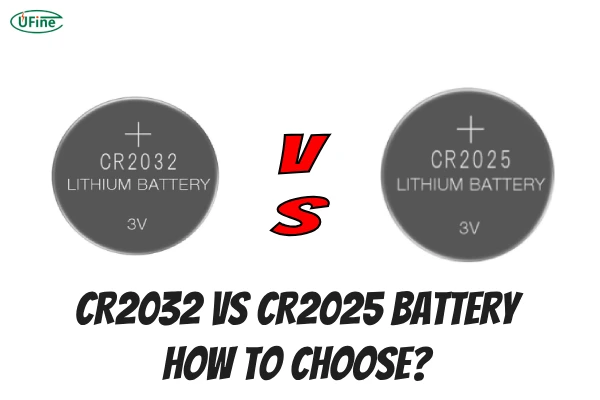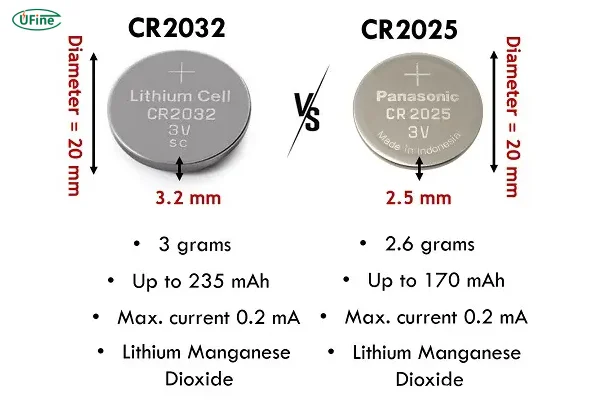
- Part 1. What does CR stand for?
- Part 2. Understanding CR2032 battery
- Part 3. Understanding CR2025 battery
- Part 4. CR2032 vs CR2025: What is the difference?
- Part 5. CR2032 vs CR2025: which one is better?
- Part 6. CR2032 vs CR2025: how to choose?
- Part 7. Can I use a CR2032 battery instead of a CR2025?
- Part 8. Are CR2032 and CR2025 rechargeable?
- Part 9. Can CR2032 and CR2025 batteries replace each other?
In a world where compact devices play a significant role in our daily lives, the importance of choosing the right battery cannot be overstated. Whether it’s your car key fob, wristwatch, or kitchen scale, the small but powerful coin batteries like CR2032 and CR2025 are what keep these gadgets running. However, many people are unsure of the differences between these two commonly used batteries. Does size matter? Is there a performance difference? How can you make the best choice for your specific device?
This article dives deep into the details of CR2032 and CR2025 batteries, guiding you through their similarities, differences, and the factors you should consider when choosing between them.

Part 1. What does CR stand for?
First, let’s clarify what “CR” stands for. “CR” is a universal code for lithium coin batteries, which use lithium manganese dioxide (LiMnO2) as their chemical composition. This chemistry provides these batteries with stable voltage and a long shelf life, typically ranging from 5 to 10 years. Lithium coin cells are used in small devices because they offer consistent, reliable power. The “CR” prefix helps distinguish them from other types of coin batteries that may use different chemistries, such as “LR” (alkaline) or “SR” (silver oxide).
So, every time you see the CR prefix on a battery, you can trust that it’s a lithium coin battery designed for low-drain, long-term use.
Part 2. Understanding CR2032 battery
The CR2032 battery is one of the most widely used coin cell batteries, known for its balance of size and capacity. Breaking down the name, “2032” provides key information about the battery’s dimensions. The first two digits, “20,” refer to its diameter, which is 20 mm. The last two digits, “32,” indicate its thickness, which is 3.2 mm.
CR2032 batteries are prized for their high capacity, typically ranging between 210 mAh and 240 mAh, making them ideal for devices that require longer-lasting power. From medical devices like glucose monitors to everyday items like car key fobs and small remote controls, CR2032 batteries deliver dependable energy, even under colder conditions where other batteries may falter.
CR Battery Sizes: A Complete Guide
Part 3. Understanding CR2025 battery
Now, let’s take a look at the CR2025 battery. Like the CR2032, the name “2025” tells you its dimensions: it is 20 mm in diameter and 2.5 mm in thickness. While the voltage output is the same at 3 volts, the thinner CR2025 has a lower capacity than the CR2032, generally between 150 mAh and 170 mAh.
Because of this smaller capacity, CR2025 batteries may not last as long as their thicker counterpart, especially in devices that require a consistent power supply. However, they are still highly effective in devices with low power consumption, such as wristwatches, small remote controls, and some medical devices like thermometers.
Part 4. CR2032 vs CR2025: What is the difference?
| Feature | CR2032 | CR2025 |
|---|---|---|
| Size | 20mm diameter, 3.2mm thickness | 20mm diameter, 2.5mm thickness |
| Capacity | 210-230mAh | 150-165mAh |
| Voltage | 3V | 3V |
| Battery Life | Longer lifespan due to higher capacity | Shorter lifespan compared to CR2032 |
| Thickness | 3.2mm | 2.5mm |
| Weight | Approximately 3.1 grams | Approximately 2.5 grams |
| Applications | Used in devices that require higher capacity, like watches, calculators, and medical devices | Used in devices with lower power needs, such as car remotes, key fobs, and smaller electronics |
| Compatibility | Can replace CR2025 in many devices if it fits | Cannot replace CR2032 in devices needing more capacity |
| Price | Slightly more expensive due to higher capacity | Generally less expensive |
Need to Know About 3 Volt Battery: A Quick Guide
Part 5. CR2032 vs CR2025: which one is better?
When it comes to choosing between CR2032 and CR2025, there is no definitive “better” option. It really depends on your specific needs. If your device requires a higher capacity battery that can last longer, such as in car key fobs or medical devices, the CR2032 would be your go-to option. On the other hand, if your device has a tighter battery compartment or only requires minimal power consumption, the CR2025 might be more suitable.
Part 6. CR2032 vs CR2025: how to choose?
Choosing between CR2032 and CR2025 depends largely on the power demands of your device and the space available in the battery compartment. For example, if your device manual specifies a CR2025, it’s likely due to size limitations. In this case, using a CR2032, even though it has a higher capacity, might not fit well. Always check the device’s battery compartment and manufacturer’s recommendation before swapping.
If your device allows either battery, consider how often you use it and how much power it consumes. For everyday items you use frequently, like remotes or fitness trackers, a CR2032 will likely save you from frequent battery changes. For devices that require occasional use, such as small toys or watches, the CR2025 should work just fine.
Part 7. Can I use a CR2032 battery instead of a CR2025?
In many cases, yes, you can use a CR2032 in place of a CR2025, but it depends on the battery compartment of your device. Since the CR2032 is thicker, it may not fit into compartments designed specifically for the thinner CR2025. However, if space allows, the CR2032’s higher capacity will give you longer battery life, making it an attractive option for devices that support both.
Part 8. Are CR2032 and CR2025 rechargeable?
Neither CR2032 nor CR2025 batteries are typically rechargeable. These are classified as primary batteries, designed for one-time use. After depletion, they should be properly disposed of. While there are rechargeable coin cell batteries available, they are often labeled with different designations, such as “LIR” for lithium-ion rechargeable variants. However, these rechargeable alternatives may not always be compatible with devices that require non-rechargeable batteries like the CR2032 or CR2025.
Part 9. Can CR2032 and CR2025 batteries replace each other?
CR2032 and CR2025 batteries can sometimes replace each other, but there are important considerations:
-
Size Difference:
- The CR2032 is 3.2mm thick, while the CR2025 is 2.5mm thick.
- If the device’s battery compartment is designed for the thinner CR2025, the thicker CR2032 may not fit properly.
-
Capacity Difference:
- The CR2032 has a higher capacity (210-230mAh) compared to the CR2025 (150-165mAh).
- Using a CR2025 in place of a CR2032 may result in shorter battery life in devices that require higher power.
-
Voltage:
- Both batteries have the same voltage (3V), so they are electrically compatible.
-
Spring-Loaded Compartments:
- In some devices with spring-loaded battery compartments, the thickness difference may not affect functionality, making them interchangeable.
When Replacement Is Possible:
- If the CR2032 fits in a CR2025 slot, it can be used and will typically last longer.
- If the device can operate with the lower capacity of a CR2025 in place of a CR2032, it can also work temporarily, but it will deplete faster.
When Replacement Is Not Recommended:
- Devices requiring a precise fit may not work well with the wrong thickness.
- High-drain devices designed for CR2032 may drain a CR2025 too quickly, leading to shorter use times.
In general, it’s best to use the battery type specified in the device manual for optimal performance and safety.
Related Tags:
More Articles

What is the Difference Between Silver Zinc Battery vs. Lithium-ion Rechargeable?
Compare silver zinc and lithium-ion rechargeable batteries: energy density, cycle life, safety, cost, and uses in drones, medical devices, EVs, and electronics.
What are Watts and Watt Hours in Battery?
Understand watt vs watt-hour in batteries: key differences, how to calculate capacity, and why they matter. Includes free comparison table.
Best 10 Blood Pressure Monitor Battery Review: Finding the Most Reliable
Are you looking for a reliable Blood Pressure Monitor battery? Here is a complete guide with the top 10 best blood pressure monitor batteries.
Bluetooth Headphone Battery Guide: All You Need to Know
Maximize headphone battery life with expert tips! Learn how to charge, check, troubleshoot, and choose the best bluetooth headphone battery in 2025.
LiFePO4 Battery VS. Lithium-ion Polymer Battery: Which One Is Best?
Comprehensive comparison of LiFePO4 vs Lithium Ion Polymer batteries: energy density, safety, lifespan, cost. Find out which battery suits your needs in 2025.





